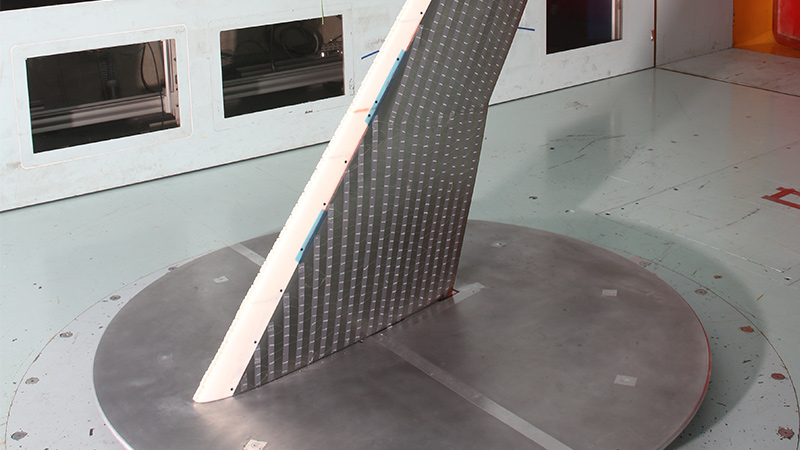Stay Up to Date
Submit your email address to receive the latest industry and Aerospace America news.
The Atmospheric and Space Environments Technical Committee encourages the exchange of information about the interactions between aerospace systems and their surroundings.
Over the past several years, NASA has collaborated with the FAA and the French Aerospace Lab, ONERA, to investigate in-flight icing on large-scale commercial transport airplanes. A major program milestone was achieved in May with the completion of a large-scale, wind-tunnel campaign focused on understanding the aerodynamic effect of highly three-dimensional ice accretion.
The campaign’s primary objective was to measure aerodynamic performance degradation due to artificial ice shapes on an 8.7 percent scale semispan, swept-wing model based on the NASA Common Research Model. The artificial ice shapes — designed in 2016 using the 3-D scan data of ice accretion measured during tests in 2015 — were completed in January. They were fabricated via rapid-prototype manufacturing and closely resembled the large-scale 3-D features of the ice accretion. Lower-fidelity artificial ice shapes without the large-scale 3-D features were also investigated.
The preliminary results indicate the large-scale 3-D features are significant with respect to the aerodynamic performance degradation associated with icing. The pressurization capability of the ONERA F1 wind tunnel was used to investigate changes in aerodynamic performance over Reynolds numbers from 1.6×106 to 12.0×106 and Mach numbers from 0.09 to 0.34. These changes were significant for the baseline, clean wing. For the wing with artificial ice shapes, the effects of Reynolds and Mach numbers were significantly reduced. This work — the first of two planned test campaigns — will help evaluate the efficacy of 3-D icing-simulation tools.
In July, Glenn and the National Research Council of Canada conducted a test to study the fundamentals of ice-crystal ice accretion. The testing at the NRC Research Altitude Test Facility in Ottawa, Ontario, sought to generate icing conditions representative of those that occur inside a jet engine when ingesting ice crystals. An airfoil was exposed to those conditions, and the resulting ice accretions were recorded. This data will help extend predictive ice-accretion codes to include conditions occurring in engine icing.
Turning to space environments, scientists analyzed data of solar array arcing aboard two GPS satellites and one Van Allen Probe satellite; a preliminary analysis was published in May in AIAA’s Journal of Spacecraft and Rockets. A team comprised of members from the U.S. Air Force Research Lab, Los Alamos National Laboratory and Assurance Technology Corp. captured the data in 2015 and 2016 with the radio telescope at the Arecibo Observatory in Puerto Rico. After eliminating narrowband interference, broadband total power was sampled at 9.6 or 19.2 microseconds per sample. The evidence for arcing is in breakpoints of autocorrelation functions of the total power signal centered at 327 and 430 megahertz, which were not present in off-source scans. The breakpoints indicated widths of 60-160 microseconds, timescales not common in broadband interference but representative of arc plasma flashover.
The possibility of detecting satellite arcing at radio frequencies was predicted in papers from 2014 to 2016. The frequency of occurrence of the observed GPS arcing is similar to the undispersed event rate seen by the Los Alamos’ U.S. Nuclear Detonation Detection System radio-frequency detectors on GPS satellites, which is highly correlated with the surface charging electron flux variations in GPS orbits as predicted by the AE9/AP9/SPM empirical magnetosphere model. The arc strength and frequency of occurrence are enough to completely account for the measured power degradation in excess of radiation damage, if the source of the excess degradation is arc-induced contamination of the GPS solar arrays. AFRL Spacecraft Charging and Instrument Calibration Laboratory arcing data on a small GPS array sample constructed and I-V tested by AFRL shows power loss consistent with the hypothesis. The frequency of arc occurrence is much greater than commonly assumed. Mitigation may prevent future excess power degradation and may make possible downsizing future GPS arrays by 20 percent with no loss of end-of-life power.
Related Posts
Stay Up to Date
Submit your email address to receive the latest industry and Aerospace America news.




